Georges Kaddoum
Senior Member, IEEE
Beyond Diagonal RIS for ISAC Network: Statistical Analysis and Network Parameter Estimation
Feb 18, 2025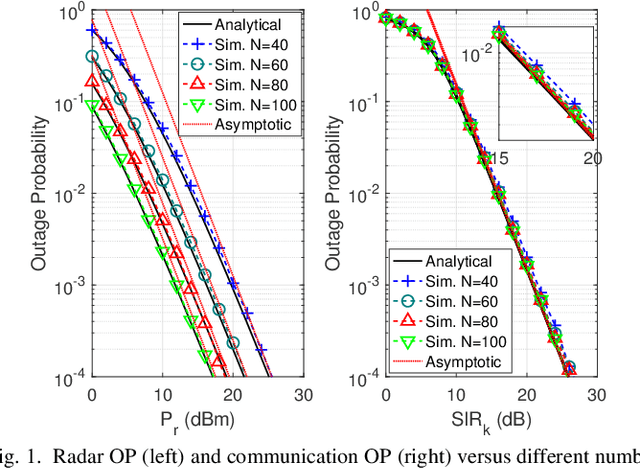
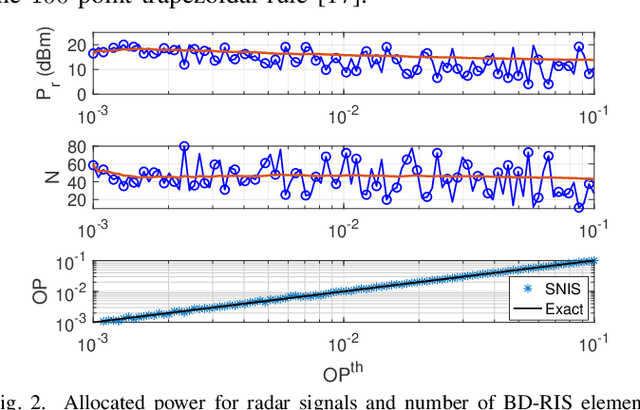
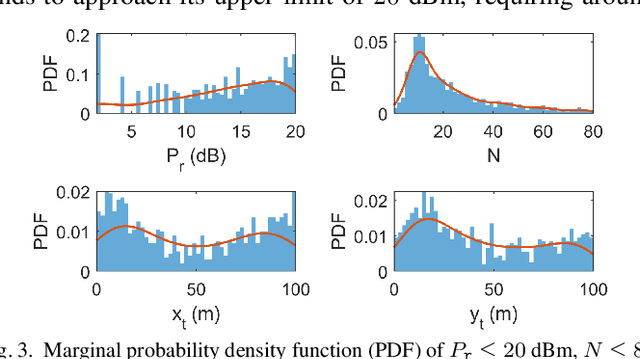
Abstract:This paper investigates the use of beyond diagonal reconfigurable intelligent surface (BD-RIS) with $N$ elements to advance integrated sensing and communication (ISAC). We address a key gap in the statistical characterizations of the radar signal-to-noise ratio (SNR) and the communication signal-to-interference-plus-noise ratio (SINR) by deriving tractable closed-form cumulative distribution functions (CDFs) for these metrics. Our approach maximizes the radar SNR by jointly configuring radar beamforming and BD-RIS phase shifts. Subsequently, zero-forcing is adopted to mitigate user interference, enhancing the communication SINR. To meet ISAC outage requirements, we propose an analytically-driven successive non-inversion sampling (SNIS) algorithm for estimating network parameters satisfying network outage constraints. Numerical results illustrate the accuracy of the derived CDFs and demonstrate the effectiveness of the proposed SNIS algorithm.
Coordinated Half-Duplex/Full-Duplex Cooperative Rate-Splitting Multiple Access in Multi-Cell Networks
Sep 02, 2024Abstract:This paper explores downlink Cooperative Rate-Splitting Multiple Access (C-RSMA) in a multi-cell wireless network with the assistance of Joint-Transmission Coordinated Multipoint (JT-CoMP). In this network, each cell consists of a base station (BS) equipped with multiple antennas, one or more cell-center users (CCU), and multiple cell-edge users (CEU) located at the edge of the cells. Through JT-CoMP, all the BSs collaborate to simultaneously transmit the data to all the users including the CCUs and CEUs. To enhance the signal quality for the CEUs, CCUs relay the common stream to the CEUs by operating in either half-duplex (HD) or full-duplex (FD) decode-and-forward (DF) relaying mode. In this setup, we aim to jointly optimize the beamforming vectors at the BS, the allocation of common stream rates, the transmit power at relaying users, i.e., CCUs, and the time slot fraction, aiming to maximize the minimum achievable data rate. However, the formulated optimization problem is non-convex and is challenging to solve directly. To address this challenge, we employ change-of-variables, first-order Taylor approximations, and a low-complexity algorithm based on Successive Convex Approximation (SCA). We demonstrate through simulation results the efficacy of the proposed scheme, in terms of average achievable data rate, and we compare its performance to that of four baseline schemes, including HD/FD cooperative non-orthogonal multiple access (C-NOMA), NOMA, and RSMA without user cooperation. The results show that the proposed FD C-RSMA can achieve 25% over FD C-NOMA and the proposed HD C-RSMA can achieve 19% over HD C-NOMA respectively, when the BS transmit power is 20 dBm.
Machine learning empowered Modulation detection for OFDM-based signals
Aug 15, 2024Abstract:We propose a blind ML-based modulation detection for OFDM-based technologies. Unlike previous works that assume an ideal environment with precise knowledge of subcarrier count and cyclic prefix location, we consider blind modulation detection while accounting for realistic environmental parameters and imperfections. Our approach employs a ResNet network to simultaneously detect the modulation type and accurately locate the cyclic prefix. Specifically, after eliminating the environmental impact from the signal and accurately extracting the OFDM symbols, we convert these symbols into scatter plots. Due to their unique shapes, these scatter plots are then classified using ResNet. As a result, our proposed modulation classification method can be applied to any OFDM-based technology without prior knowledge of the transmitted signal. We evaluate its performance across various modulation schemes and subcarrier numbers. Simulation results show that our method achieves a modulation detection accuracy exceeding $80\%$ at an SNR of $10$ dB and $95\%$ at an SNR of $25$ dB.
Ground-to-UAV and RIS-assisted UAV-to-Ground Communication Under Channel Aging: Statistical Characterization and Outage Performance
Aug 01, 2024Abstract:This paper studies the statistical characterization of ground-to-air (G2A) and reconfigurable intelligent surface (RIS)-assisted air-to-ground (A2G) communications in RIS-assisted UAV networks under the impact of channel aging. A comprehensive channel model is presented, which incorporates the time-varying fading, three-dimensional (3D) mobility, Doppler shifts, and the effects of channel aging on array antenna structures. We provide analytical expressions for the G2A signal-to-noise ratio (SNR) probability density function (PDF) and cumulative distribution function (CDF), demonstrating that the G2A SNR follows a mixture of noncentral $\chi^2$ distributions. The A2G communication is characterized under RIS arbitrary phase-shift configurations, showing that the A2G SNR can be represented as the product of two correlated noncentral $\chi^2$ random variables (RVs). Additionally, we present the PDF and the CDF of the product of two independently distributed noncentral $\chi^2$ RVs, which accurately characterize the A2G SNR's distribution. Our paper confirms the effectiveness of RISs in mitigating channel aging effects within the coherence time. Finally, we propose an adaptive spectral efficiency method that ensures consistent system performance and satisfactory outage levels when the UAV and the ground user equipments are in motion.
Fluctuating Line-of-Sight Fading Distribution: Statistical Characterization and Applications
Aug 01, 2024



Abstract:We introduce the fluctuating Line-of-Sight (fLoS) fading model, characterized by parameters $K$, $k$, $\lambda$, and $\Omega$. The fLoS fading distribution is expressed in terms of the multivariate confluent hypergeometric functions $\Psi_2$, $\Phi_3^{(n)}$, and $\Phi_3 = \Phi_3^{(2)}$ and encompasses well-known distributions, such as the Nakagami-$m$, Hoyt, Rice, and Rician shadowed fading distributions as special cases. An efficient method to numerically compute the fLoS fading distribution is also addressed. Notably, for a positive integer $k$, the fLoS fading distribution simplifies to a finite mixture of $\kappa$-$\mu$ distributions. Additionally, we analyze the outage probability and Ergodic capacity, presenting a tailored Prony's approximation method for the latter. Numerical results are presented to show the impact of the fading parameters and verify the accuracy of the proposed approximation. Moreover, we illustrate an application of the proposed fLoS fading distribution for characterizing wireless systems affected by channel aging.
Aging-Resistant Wideband Precoding in 5G and Beyond Using 3D Convolutional Neural Networks
Jul 10, 2024



Abstract:To meet the ever-increasing demand for higher data rates, 5G and 6G technologies are shifting transceivers to higher carrier frequencies, to support wider bandwidths and more antenna elements. Nevertheless, this solution poses several key challenges: i) increasing the carrier frequency and bandwidth leads to greater channel frequency selectivity in time and frequency domains, and ii) the greater the number of antennas the greater the the pilot overhead for channel estimation and the more prohibitively complex it becomes to determine the optimal precoding matrix. This paper presents two deep-learning frameworks to solve these issues. Firstly, we propose a 3D convolutional neural network (CNN) that is based on image super-resolution and captures the correlations between the transmitting and receiving antennas and the frequency domains to combat frequency selectivity. Secondly, we devise a deep learning-based framework to combat the time selectivity of the channel that treats channel aging as a distortion that can be mitigated through deep learning-based image restoration techniques. Simulation results show that combining both frameworks leads to a significant improvement in performance compared to existing techniques with little increase in complexity.
DRL-Based Dynamic Channel Access and SCLAR Maximization for Networks Under Jamming
Feb 02, 2024Abstract:This paper investigates a deep reinforcement learning (DRL)-based approach for managing channel access in wireless networks. Specifically, we consider a scenario in which an intelligent user device (iUD) shares a time-varying uplink wireless channel with several fixed transmission schedule user devices (fUDs) and an unknown-schedule malicious jammer. The iUD aims to harmoniously coexist with the fUDs, avoid the jammer, and adaptively learn an optimal channel access strategy in the face of dynamic channel conditions, to maximize the network's sum cross-layer achievable rate (SCLAR). Through extensive simulations, we demonstrate that when we appropriately define the state space, action space, and rewards within the DRL framework, the iUD can effectively coexist with other UDs and optimize the network's SCLAR. We show that the proposed algorithm outperforms the tabular Q-learning and a fully connected deep neural network approach.
Joint Devices and IRSs Association for Terahertz Communications in Industrial IoT Networks
Feb 01, 2024
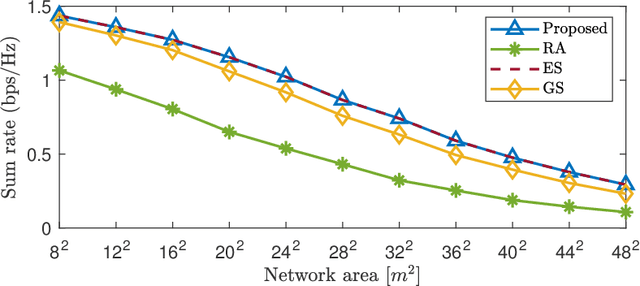

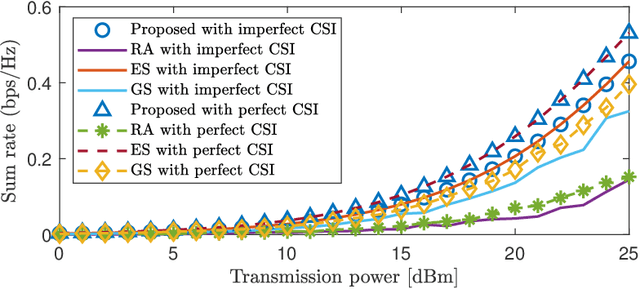
Abstract:The Industrial Internet of Things (IIoT) enables industries to build large interconnected systems utilizing various technologies that require high data rates. Terahertz (THz) communication is envisioned as a candidate technology for achieving data rates of several terabits-per-second (Tbps). Despite this, establishing a reliable communication link at THz frequencies remains a challenge due to high pathloss and molecular absorption. To overcome these limitations, this paper proposes using intelligent reconfigurable surfaces (IRSs) with THz communications to enable future smart factories for the IIoT. In this paper, we formulate the power allocation and joint IIoT device and IRS association (JIIA) problem, which is a mixed-integer nonlinear programming (MINLP) problem. {Furthermore, the JIIA problem aims to maximize the sum rate with imperfect channel state information (CSI).} To address this non-deterministic polynomial-time hard (NP-hard) problem, we decompose the problem into multiple sub-problems, which we solve iteratively. Specifically, we propose a Gale-Shapley algorithm-based JIIA solution to obtain stable matching between uplink and downlink IRSs. {We validate the proposed solution by comparing the Gale-Shapley-based JIIA algorithm with exhaustive search (ES), greedy search (GS), and random association (RA) with imperfect CSI.} The complexity analysis shows that our algorithm is more efficient than the ES.
Statistical Characterization of RIS-assisted UAV Communications in Terrestrial and Non-Terrestrial Networks Under Channel Aging
Jan 30, 2024Abstract:This paper studies the statistical characterization of ground-to-air (G2A) and reconfigurable intelligent surface (RIS)-assisted air-to-ground (A2G) communications with unmanned aerial vehicles (UAVs) in terrestrial and non-terrestrial networks under the impact of channel aging. We first model the G2A and A2G signal-to-noise ratios (SNRs) as non-central complex Gaussian quadratic random variables (RVs) and derive their exact probability density functions, offering a unique characterization for the A2G SNR as the product of two scaled non-central chi-square RVs. Moreover, we also find that, for a large number of RIS elements, the RIS-assisted A2G channel can be characterized as a single Rician fading channel. Our results reveal the presence of channel hardening in A2G communication under low UAV speeds, where we derive the maximum target spectral efficiency (SE) for a system to maintain a consistent required outage level. Meanwhile, high UAV speeds, exceeding 50 m/s, lead to a significant performance degradation, which cannot be mitigated by increasing the number of RIS elements.
Channel Characterization of UAV-RIS-aided Systems with Adaptive Phase-shift Configuration
Jan 30, 2024Abstract:This letter considers a UAV aiding communication between a ground transmitter and a ground receiver in the presence of co-channel interference. A discrete-time Markov process is adopted to model the complex nature of the Air-to-Ground (A2G) channel, including the occurrence of Line-of-Sight, Non-Line-of-Sight, and blockage events. Moreover, an adaptive phase-shift-enabled Reconfigurable Intelligent Surface (RIS) is deployed to combat A2G blockage events. Novel frameworks based on the shadowed Rician distribution are proposed to derive closed-form expressions for Ground-to-Air/A2G SINR' distributions. Numerical results show that RISs with large numbers of elements, e.g., 256 RIS elements, improve end-to-end Outage Probability (OP) and reduce blockages.
 Add to Chrome
Add to Chrome Add to Firefox
Add to Firefox Add to Edge
Add to Edge